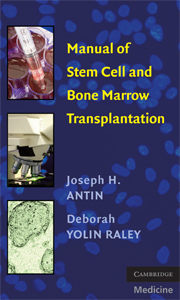Book contents
- Frontmatter
- Contents
- Acknowledgments
- Manual of Stem Cell and Bone Marrow Transplantation
- 1 Rationale for Transplantation
- 2 Types of Transplantation
- 3 HLA Matching in Allogeneic Transplantation
- 4 Stem Cell Source
- 5 Pretransplant Evaluation and Counseling of Patient and Donor
- 6 Conditioning Regimens
- 7 Stem Cell Infusion
- 8 ABO Compatibility
- 9 Engraftment
- 10 Preventative Care
- 11 Transplant-Related Complications
- 12 Graft-Versus-Host Disease – Prophylaxis and Acute
- 13 Graft-Versus-Host Disease – Chronic
- 14 Engraftment Syndrome
- 15 Infectious Disease
- 16 Graft Rejection And Failure
- 17 Gastrointestinal Complications
- 18 Pulmonary Complications
- 19 Veno-Occlusive Disease
- 20 Special Transfusion-Related Situations
- 21 Cardiovascular Complications
- 22 Neurologic Complications
- 23 Cystitis
- 24 Donor Lymphocyte Infusion
- 25 Transplantation: Regulation And Accreditation
- Appendix
- Index
4 - Stem Cell Source
Published online by Cambridge University Press: 23 November 2009
- Frontmatter
- Contents
- Acknowledgments
- Manual of Stem Cell and Bone Marrow Transplantation
- 1 Rationale for Transplantation
- 2 Types of Transplantation
- 3 HLA Matching in Allogeneic Transplantation
- 4 Stem Cell Source
- 5 Pretransplant Evaluation and Counseling of Patient and Donor
- 6 Conditioning Regimens
- 7 Stem Cell Infusion
- 8 ABO Compatibility
- 9 Engraftment
- 10 Preventative Care
- 11 Transplant-Related Complications
- 12 Graft-Versus-Host Disease – Prophylaxis and Acute
- 13 Graft-Versus-Host Disease – Chronic
- 14 Engraftment Syndrome
- 15 Infectious Disease
- 16 Graft Rejection And Failure
- 17 Gastrointestinal Complications
- 18 Pulmonary Complications
- 19 Veno-Occlusive Disease
- 20 Special Transfusion-Related Situations
- 21 Cardiovascular Complications
- 22 Neurologic Complications
- 23 Cystitis
- 24 Donor Lymphocyte Infusion
- 25 Transplantation: Regulation And Accreditation
- Appendix
- Index
Summary
HEMATOPOIETIC PROGENITOR CELL PRODUCTS
Hematopoietic progenitor cell (HPC) products contain hematopoietic stem and lineage-committed progenitor cells capable of providing hematopoietic and immune reconstitution after myeloablative or reduced-intensity preparative regimens. There is no unanimity on the terminology.
Since stem cells are difficult to specifically identify, some authors prefer the term hematopoietic cell transplantation (HCT).
Others call the procedure hematopoietic stem cell transplantation (HSCT) to acknowledge that most transplantations are not successful unless stem cells are transplanted.
The Foundation For The Accreditation of Cellular Therapy (FACT) focuses on progenitors. Cellular therapy products can be broadly categorized as being minimally manipulated products and more than minimally manipulated products.
Hematopoietic Progenitor Cell Function
Hematopoietic progenitor cells (HPCs) administered intravenously migrate to the marrow, where they adhere, expand, selfrenew (stem cells only), and differentiate. The differentiated cells are released into the blood, restoring blood counts and immunity. The time from administration of HPCs to recovery of adequate or normal blood counts is variable (see section on Engraftment).
Indications
Allogeneic HPC products are intended to provide hematopoietic reconstitution after myeloablative or reduced intensity preparative regimens for a wide range of disease states. For some patients the product is also intended to provide a graft-versus-tumor effect. Autologous HPCs are collected and stored for use as a “rescue” following myeloablative or severely myelotoxic therapy. The high-dose therapy is intended to treat the patient's underlying malignancy and autologous HPC products are administered to minimize morbidity and mortality due to the myelotoxic effects of the therapy.
- Type
- Chapter
- Information
- Manual of Stem Cell and Bone Marrow Transplantation , pp. 9 - 15Publisher: Cambridge University PressPrint publication year: 2009
- 1
- Cited by



